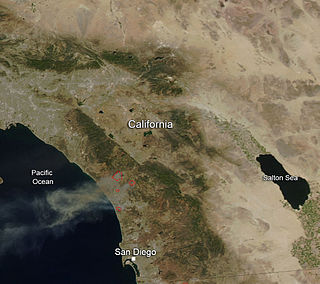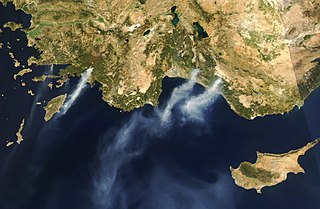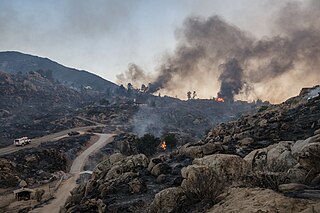
A helicopter bucket or helibucket is a specialized bucket suspended on a cable carried by a helicopter to deliver water for aerial firefighting. The design of the buckets allows the helicopter to hover over a water source—such as a lake, river, pond, or tank—and lower the bucket into the water to refill it. This allows the helicopter crew to operate the bucket in remote locations without the need to return to a permanent operating base, reducing the time between successive drops.

Aerial firefighting, also known as waterbombing, is the use of aircraft and other aerial resources to combat wildfires. The types of aircraft used include fixed-wing aircraft and helicopters. Smokejumpers and rappellers are also classified as aerial firefighters, delivered to the fire by parachute from a variety of fixed-wing aircraft, or rappelling from helicopters. Chemicals used to fight fires may include water, water enhancers such as foams and gels, and specially formulated fire retardants such as Phos-Chek.

The Sikorsky S-64 Skycrane is an American twin-engine heavy-lift helicopter. It is the civil version of the United States Army's CH-54 Tarhe. It is currently produced as the S-64 Aircrane by Erickson Inc.

The Yellowstone fires of 1988 collectively formed the largest wildfire in the recorded history of Yellowstone National Park in the United States. Starting as many smaller individual fires, the flames quickly spread out of control due to drought conditions and increasing winds, combining into several large conflagrations which burned for several months. The fires almost destroyed two major visitor destinations and, on September 8, 1988, the entire park was closed to all non-emergency personnel for the first time in its history. Only the arrival of cool and moist weather in the late autumn brought the fires to an end. A total of 793,880 acres (3,213 km2), or 36 percent of the park, burned at varying levels of severity.
Wildfire suppression equipment and personnel is part of the science of fire fighting focusing on the use of specialized equipment, training and tactics to effectively control, surround and eventually extinguish a natural cover fire. There are several specially designed tools that through their function and user training, perform specialized tasks that are specific to natural cover firefighting. This is used together in conjunction with the general understanding of the behavior of fire to form a viable plan of attack.

The Bastrop County Complex fire was a conflagration that engulfed parts of Bastrop County, Texas, in September and October 2011. The wildfire was the costliest and most destructive wildfire in Texas history and among the costliest in U.S. history, destroying 1,696 structures and causing an estimated $350 million in insured property damage. An exceptional drought, accompanied by record-high temperatures, affected Texas for much of 2011. Vegetation consequently became severely parched throughout the state, and over the year an unprecedented amount of land in the state was burned by numerous wildfires. In early September 2011, the presence of Tropical Storm Lee to the east produced strong northerly winds over the state, exacerbating the preexisting dry weather to produce critical fire conditions. On the afternoon of September 4, 2011, three separate fires ignited in the wildland–urban interface east of Bastrop, Texas, after strong winds caused by the nearby tropical storm snapped trees onto power lines. Within 48 hours, fires merged into one blaze that quickly consumed parts of Bastrop State Park and parts of the Lost Pines Forest, as well as homes in nearby subdivisions. Most of the conflagration's spread and destruction occurred within a week of ignition, as the forward advance of the wildfire mostly stopped after September 7. The wildfire was largely contained in September, though the firebreak was briefly breached in early October. On October 10, the Bastrop County Complex was declared controlled and the fire was declared extinguished on October 29 after 55 days of burning within the fire perimeter.

2014 saw several notable wildfires igniting in California, especially during the month of May, when multiple fires were ablaze concurrently in Southern California, and during September, when several massive wildfires were burning in Northern California. In the context of the 2012–13 North American drought, as well as powerful Santa Ana winds, weather conditions were ideal for wildfires. A total of 7,865 wildfires ignited throughout the year, which burned at least 625,540 acres (2,531.5 km2) of land. The wildfires caused a total of 146 injuries and 2 fatalities, in addition to causing at least $204.05 million in damage.

The May 2014 San Diego County wildfires were a swarm of 20 wildfires that erupted during May 2014, in San Diego County, California, during severe Santa Ana Wind conditions, historic drought conditions, and a heat wave. The main event during mid-May was preceded by a precursor fire that ignited on May 5. The Bernardo Fire has been declared accidental, and officials believe the Cocos Fire was intentionally set. The causes of the other fires are still under investigation by multiple agencies, and a joint task force was formed to coordinate the investigations and facilitate communications. Six injuries and one fire-related fatality were reported.

The 2015 Cape wildfires were a series of wildfires that burned across the Western Cape from February to April 2015. Major fires burned across the Cape Peninsula starting on 1 March in Muizenberg and burning until 9 March, when firefighters extinguished it. The fire resulted in 1 death, 56 injuries, over 6,900 hectares of burnt land, and 13 damaged properties, of which 3 were destroyed. The cause of the fire was later determined to be arson. There were also major fires near Wellington and Porteville starting in February, which claimed the lives of 3 firefighters and a fire in Stellenbosch that caused the evacuation of the University of Stellenbosch and burned over 2,900 hectares of land.

On May 1, 2016, a wildfire began southwest of Fort McMurray, Alberta, Canada. On May 3, it swept through the community, forcing the largest wildfire evacuation in Alberta's history, with upwards of 88,000 people forced from their homes. Firefighters were assisted by personnel from both the Canadian Armed Forces and Royal Canadian Mounted Police, as well as other Canadian provincial agencies, to fight the wildfire. Aid for evacuees was provided by various governments and via donations through the Canadian Red Cross and other local and national charitable organizations.

The Soberanes Fire was a large wildfire that burned 57 homes and killed a bulldozer operator, and cost about $260 million to suppress, making it at the time the most expensive wildfire to fight in United States history. The Soberanes Fire was the result of an illegal campfire in Garrapata State Park. The fire burned 132,127 acres (53,470 ha) along the Big Sur coast in the Los Padres National Forest, Ventana Wilderness, and adjacent private and public land in Monterey County, California. At the fire's peak, over 5,000 personnel were assigned to the blaze. At the time that it was extinguished, the Soberanes fire ranked 18th on the list of the top 20 largest California wildfires, in terms of acreage burned.

The 2018 Washington wildfire season officially began June 1, 2018. A statewide state of emergency was declared by Governor Jay Inslee on July 31.

The 1998 Florida wildfires, sometimes referred to as the Florida Firestorm, was a wildfire event involving several thousand separate woodland and mixed urban-rural wildfires which wrought severe damage during the summer months of 1998. Wildfires sparked mainly by lightning threatened to converge into single, vast blazes, crossed natural firebreaks such as rivers and interstate highways, and demanded an unprecedented suppression response of firefighting resources from across the country. Regular activities such as Fourth of July celebrations, sporting events, tourism, and daily life were profoundly interrupted for millions of residents and visitors in the northeastern part of the state.

The Cameron Peak fire was a wildfire that started near Chambers Lake, Colorado, 25 miles (40 km) east of Walden and 15 miles (24 km) southwest of Red Feather Lakes near Cameron Pass on August 13, 2020, and was declared 100% contained on December 2, 2020. The fire burnt 208,663 acres through the Arapaho and Roosevelt National Forests in Larimer and Jackson Counties and Rocky Mountain National Park. At its peak, the fire forced the evacuation of over 6,000 residents in Estes Park, Chambers Lake, Rustic, Glacier View Meadows, Red Feather Lakes, Masonville, Glen Haven, Spring Canyon, various small communities along Highway 14, Stove Prairie Landing Road, as well as the Colorado State University Mountain Campus and had over 1,000 personnel fighting the fire. 469 structures were destroyed by the fire, including 220 outbuildings and 42 primary residences. The fire became the largest wildfire in Colorado history, surpassing the Pine Gulch Fire, which had set the same mark just seven weeks prior.

The Goodwin Fire was a wildfire that burned 28,516 acres (11,540 ha) in the U.S. state of Arizona over 16 days, from June 24 to July 10, 2017. The fire destroyed 17 homes and damaged another 19 structures, but no firefighters or civilians were injured or died in the fire. Investigators did not determine any particular cause for the fire.

In July and August 2021, a series of more than two hundred wildfires burnt 1,700 square kilometres of forest in Turkey's Mediterranean Region in the worst-ever wildfire season in the country's history. The wildfires started in Manavgat, Antalya Province, on 28 July 2021, with the temperature around 37 °C (99 °F). As of 9 August 2021, two fires were still burning, both in Muğla. The fires are part of a larger series of wildfires, including those in neighbouring Greece, originating from a heatwave made more likely by climate change.

The Tiger Fire was a wildfire that burned 16,278 acres (6,587 ha) in the U.S. state of Arizona from June to July 2021. The fire was caused by a dry lightning strike in the Prescott National Forest. Although Horsethief Basin Lake was evacuated and both the community of Crown King and the census-designated place of Black Canyon City were threatened, no injuries or deaths were reported, and no buildings were destroyed. Over 300 fire personnel were assigned to contain the blaze.

The Oak Fire was a destructive wildfire that burned north of the community of Bootjack in Mariposa County, California and in the Sierra National Forest, during the 2022 California wildfire season. The fire was reported on July 22, 2022, and burned 19,244 acres (7,788 ha) before being fully contained on August 10, 2022. On June 16, 2023, a 71-year-old man was arrested on suspicion of arson for starting the fire.

The Fairview Fire is a deadly and destructive wildfire that burned during the 2022 California wildfire season southwest of Valle Vista and east of Hemet in Riverside County, California in the United States. The fire ignited on September 5, 2022, during a severe heatwave that had plagued much of the southwest throughout early September and, due to the extreme weather conditions, grew to a deadly and destructive conflagration in the chaparral-filled foothills within just several hours of igniting.

The 49er Fire was a large and destructive wildfire in September 1988 in the U.S. state of California's Nevada County and Yuba County. After igniting on the morning of September 11, when a homeless schizophrenic man accidentally set brush alight by burning toilet paper, the fire burned 33,700 acres throughout the foothills of the Sierra Nevada, impinging on the communities of Lake Wildwood, Rough and Ready, and Smartsville, before being declared contained on September 16. Driven by severe drought conditions and strong, dry winds, firefighting crews were hard-pressed to stop the fire's advance until winds calmed and humidity levels recovered.



















